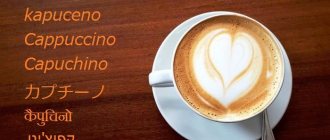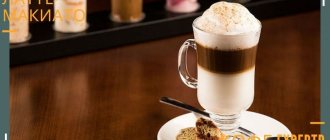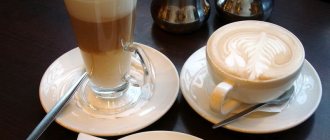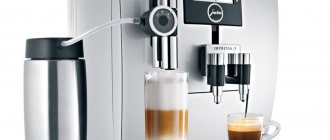When you come to a coffee shop, you want to drink coffee with milk and at the same time look like a cultured person. The question arises: where to put the emphasis in the word “latte”?
When ordinary people , who have practically nothing to do with philology, talk about the original Russian language, they do not even suspect how many words in modern Russian are borrowed . We are not talking about obvious options at all, like “merchandiser”. A huge number of words that many consider “native” are, in fact, borrowings.
In particular, we are talking about borrowings from the Latin language, which became the basis for most European words. Terms related to jurisprudence, statehood and many others are often borrowed from Latin.
Moreover, this process actively continues, and the language is enriched (or polluted, as is sometimes believed) with new words. Take, for example, the word “latte,” which came to us from Italy with its coffee culture. In general, many coffee terms come from Italy: “espresso”, “cappuccino” and the like.
Latte, in turn, is simply “milk”. This is the original translation.
Only language always strives for simplification and, so to speak, cost optimization. In this regard, various abbreviations, short forms of words and the like appear.
Originally, “café au lait” was pronounced “caffe latte . If you ask for a “latte” in a coffee shop in Italy , then most often (especially outside the tourist area) they will pour you just milk , or warm milk, or frothed milk. In order to get coffee with milk, you need to order a “caffe latte”.
At the same time, in the Russian-speaking (and not only) space, the term has been simplified to a simple “latte”, and when they say this word, they mean a special recipe for coffee with milk.
Latte pronunciation and correct stress
Let’s immediately make a reservation that it is written as well as pronounced, without cases and without declensions.
If the language norm is violated, you can hear the following phrases:
- Order for two lattes.
- Coffee shop with good lattes.
Many people are puzzled by the emphasis on the first vowel in the word latte
But this is Italian. And almost all their words are pronounced with the emphasis on the first syllable. There are exceptions, as in any other language. The pronunciation of latte in Russian should also be appropriate. So pronounce "milk" in Italian with the first stressed syllable and you'll be fine.
How to pronounce
Perhaps confusion with pronunciation occurs due to the fact that many consider this name to be French. After all, most gastronomic borrowings came into the Russian language from France. And in French, as you know, the last syllable is almost always stressed. In order not to be mistaken in this way, all coffee connoisseurs need to know about the origin of the name of this tart drink.
People who pronounce the name of a popular coffee in the French manner wonder whether it is possible to say latte with an accent on the end. Moreover, this pronunciation option is more common in our country.
At the present stage of language development, the question of where to put the stress in the word latte has one answer: on the first syllable, only this option is commonly used and preferred.
However, Russian stress is flexible in nature and recently there has been a tendency for it to shift from the beginning of the word to the end. In addition, the stress on the last syllable makes the pronunciation of the word more natural in Russian. Given these factors, it can be assumed that after some time, stress at the end of the word will become the norm.
Life stories
There are quite a few stories of tourists getting into trouble in Italy. They are funny, incidental, but end well. Here, for example, is about a tourist girl who, caught in the pouring rain and getting wet to the skin, decided to warm up with a cup of coffee, ordering just a latte. She was served milk, and heated milk at that. Naturally this caused confusion. But the incident was quickly resolved. They explained to her what she had actually ordered.
Therefore, in the future, when you come to Italy, it is best to say the entire phrase when ordering at a coffee shop: “An caffe latte, per favor.” You will receive a portion of a delicious, hot coffee drink prepared according to all the rules.
How do you say it in Russian: it or he
Another question worries many lovers of this gourmet coffee: “What kind of noun is latte? What is the correct way to talk about this drink, he or it?” The gender of the word latte is also not entirely clear.
- 5 recipes for making a gentle latte for those who have a coffee machine
Authoritative dictionaries write that this word can be neuter or masculine, like the similar nouns “cappuccino” and “espresso”. Both usages will be correct. Both options will be equivalent, unlike the use of the noun coffee, which has only a masculine gender.
What causes confusion in accents?
They confuse the pronunciation of latte and the accent, believing that this word has French roots. And all because gastronomic culinary masterpieces are mostly borrowed from French chefs. And usually in French, the emphasis in words is on the last syllable.
In our country, most people pronounce latte in the French manner. You just need to remember that the birthplace of latte is Italy and then speech errors can be avoided. This is the commonly used and preferred option.
Correct borrowing, when pronouncing words, is the culture and education of any inhabitant of our planet.
Difficulties with foreign words
There are many interesting recipes, each of which has its fans. For example, delicious and sweet iced coffee. There are usually no difficulties in pronouncing this word, but you can often see a spelling mistake. The name of this recipe is correctly written with one letter “c”, as it comes from the French “glace”, which translates to “frozen” or “ice”. The following words also deserve special attention:
- barista;
- cappuccino;
- tiramisu;
- Americano;
- espresso.
You might be interested in Coffee tree at home
Coffee sommelier and specialist in preparing various types of coffee - barista. This word cannot be declined; it is always masculine. Therefore, it is correct to say: “She is an excellent barista.”
The name of the much-loved coffee recipe “Americano” does not yet have a fixed rule, but linguists are inclined to believe that it is a masculine word.
It is often difficult to spell the name “cappuccino”. In the menus of restaurants and cafes you can often see common errors, or rather double consonants “p” or “ch”. It is necessary to remember that the spelling “cappuccino” is the only correct one.
What's the calorie content?
In the calculation process, simple mathematics and knowledge of the calorie content of milk will help us (see how to determine the calorie content of coffee). Regular varieties have an indicator of 40-60 kcal. per 100 grams. Next, you need to calculate how much milk you use to prepare your portion of the drink. If this is the same 100 grams, then the calorie content of your latte will be 40-60 kcal. (depending on the type of milk).
In calculations we always rely only on the calorie content of milk. If you ordered a 200 ml serving of coffee, you need to remember that the milk will be approximately half the volume. Based on this, carry out calculations.
Coffee has an extremely low calorie content, about 2 kcal. per 100 grams of product. Therefore, these data can be ignored.
How to put the accent correctly in the word LATTE?
In this recent borrowing, the word “latte”, the emphasis in any case must be placed on the first syllable - l A tte.
This word entered our lives not so long ago, so it has not yet “got used” to Russian grammatical rules and pronunciation, raising many questions about how to correctly place the emphasis. This word means a café au lait drink in which layers of espresso, milk and milk foam are poured into a tall glass or just a cup.
An inconvenient word for our language, indeclinable and with a double consonant, nevertheless denotes one of the realities of our life today: the exquisite drink has many fans, but not knowing where to put the emphasis, they experience discomfort when ordering a latte in a cafe.
It is worth paying attention to the fact that the word is used in both the masculine and neuter gender (like the word “coffee” itself: it used to be exclusively masculine, then both options took place, now the neuter gender is considered the most preferable).
Types of latte
Latte macchiato
Latte macchiato uses the same ingredients as a classic latte. Black coffee is brewed in the same way and milk is frothed. The milk is then poured into a glass for Irish coffee. Black coffee is poured into the frothed milk in a thin stream.
The specific gravity of coffee is less than that of milk, so the drink in the glass stratifies: the milk settles to the bottom, the coffee sits above it, and on top there is snow-white foam with a speck of coffee: translated from Italian, macchiato means “stained.” The effectiveness of the speck can be emphasized by sprinkling it with chocolate chips.
Ghetto latte
Black coffee and a glass of whipped milk are served separately. The guest himself selects the proportions of the ingredients.
How to remember where the emphasis is?
To remember which syllable the stress falls on in the word lAtte , you need to know that it came to us from the Italian language, and in it the stress rarely falls on the last syllable. Compare, for example, with the words cappuccino, macchiato, barista. All these “coffee” words also come from Italy. Probably, the errors are associated with the assumption that the name came from France (as you know, the French, on the contrary, usually put the emphasis on the last syllable). But in the word latte the stress is on the first syllable.
To remember where to put the emphasis in the word latte, you can use the mnemonic formula “LAtte sweet ”; To do this, you need to imagine the combination and remember the pronunciation based on the consonance of the words.
Also, many people are good at retaining various poems in their memory. For example, like this:
In Zlata's cup
Fragrant l Atte .
For meringue and l Atte .
A coffee drink with a unique taste
The opinion that a latte is a regular coffee with milk is wrong. In fact, this is a dessert with a pleasant aroma, an original soft taste with a slight bitterness, making it more pronounced. When preparing it, it is necessary to correctly correlate the proportions of products.
The classic recipe includes the following ingredients:
- freshly ground coffee beans for making espresso;
- clean drinking water;
- milk;
- sugar.
Italians pour espresso into heated milk, previously whipped into foam. Coffee is poured along the side of the glass so that the milk foam is at the top. The resulting ratio is 1:2:1. A layered three-layer drink is not difficult to prepare in a coffee machine or Turk.
You can give the milk foam a beautiful pattern using toothpicks. To create an unusual design, the latte art technique is used. Fantasy is not limited; various patterns are used.
The dessert is prepared according to Italian, Irish, English and other recipes. The options are similar, but the ingredients and proportions are different.
The drink is served in a special glass Irish glass on a napkin. Some people prefer sweets. The dessert is decorated with fresh berries: blueberries, raspberries, blackberries. You can add whipped cream on top of the milk. The calorie content increases, but the dish becomes very appetizing.
Latte macchiato
One of the varieties of a popular drink is latte macchiato. In the traditional recipe, cinnamon or chocolate is useful, but coffee dessert can also be prepared with the addition of syrup or caramel.
- 50 ml espresso;
- 150 ml milk 3% fat;
- cinnamon (chocolate);
- sugar.
First the milk is prepared. It needs to be heated to 70 degrees and whipped into foam using a mixer, blender or French press. Immediately brew espresso using any usual method and carefully add it to the heated milk. The drink is decorated with cinnamon or chocolate chips, you can add sugar to taste.
When making dessert, you can use grain or instant coffee. If you want to enjoy the generous color, then choose the freshly ground version. Use only the freshest ingredients to create a real culinary masterpiece.
Classic latte recipe
Ingredients:
- espresso (other black coffee) – 50-60 ml;
- fresh milk – 100-180 ml.
Cooking technology
- Whisk the milk.
- Prepare black coffee.
- Pour the coffee into an Irish coffee glass or ceramic cup.
- Pour milk in a thin stream. In this case, the liquids should mix, and a foam about 1 cm thick should form on the surface.
This is a basic latte recipe. It can be varied by mixing coffee with 10–20 ml of sweet syrup. To obtain vanilla flavor, milk is mixed with vanilla before whipping. The foam can be lightly sprinkled with cinnamon or chocolate chips.
How to write on the menu
There are far fewer difficulties with spelling the latte drink than with pronunciation. Its name is written with two consonants "t". This is easy to remember because when we pronounce this word we usually double the hard “t” sound.
In this regard, coffee with milk is more fortunate than iced glass, cappuccino, espresso or tiramisu. The spelling of these borrowed words is often misspelled.
Correct pronunciation of borrowings is very important for any person; it is an indicator of culture and education. Now you know which syllable to emphasize, and you will order a latte in cafes and restaurants correctly. We hope that this mysterious name has become clear and simple for you.
Making latte
We had a separate material in which we discussed aspects and main recipes (see how to make latte at home). Be sure to read it.
As part of this material, I want to show you the most common recipe.
- Milk 2 percent fat 100 ml;
- 2 teaspoons ground coffee;
- Cinnamon and sugar to taste.
If you have the opportunity to make espresso in a coffee machine, do it. If you don’t have it on hand, brew coffee in a Turk or pour boiling water into any convenient container (see coffee filters). Then drain it using a sieve into a glass.
The next step we need to prepare milk foam. Pour the milk into a saucepan and place over low heat. Now start whipping it using a mixer. You need to bring it to a temperature of 60-70 degrees. It should not boil - watch this!
When finished, pour the milk into a glass of coffee. You should end up with a drink consisting of 3 layers - coffee, milk and milk foam. Add sugar to taste and garnish with cinnamon.
An exciting addition. The title will depend on the order in which you add the ingredients. In a traditional latte, milk is added to the finished coffee. A drink in which coffee is poured into milk is called latte mochiato.
How to serve the drink?
You can use any cookware that meets several requirements. It must have transparent walls and be sufficiently heat-resistant.
Not the last element in serving this type of coffee is aesthetics. When prepared correctly, you will end up with a drink consisting of several clearly separated layers. And this should be seen by the person who will try it.
In establishments, it is customary to serve lattes in Irish glasses. They look like this:
How to understand the correct accent
If it is difficult for you to get rid of the incorrect emphasis at the end, you can keep in mind the formula to remember: “Latte is sweet.” Or come up with your own. Then language difficulties will not prevent you from enjoying the taste of a delicious drink.
By the way, if you go to Italy and want to order a cup of fragrant latte there, the usual 1st word will not be enough. Instead of a coffee drink, they will bring you a glass of milk. When ordering in Italy, it is recommended to say, like the locals, caffe latte, then you will be understood correctly.
History of the conquest of the world
Without exaggeration, let's call latte a “conqueror”, in the best sense of this brutal word. There are not many drinks on Earth that, having originated in one country, captivated the rest of the world with their merits. A simple mixture of coffee and milk created the most popular drink!
Americans claim the laurels of discoverers, claiming that in the middle of the last century the latte was invented by a certain bartender from California. And yet, the all-powerful inhabitants of the New World are unable to deny the Italian roots of the bartender - an emigrant from Europe. The mark of the Apennine peninsula boot remains forever on the name of latte.
In this case, justice triumphs; all over the world, latte is considered an Italian invention. The first tasters of the drink were children of Italian families, for whom their mothers, who had no idea that they were opening a new brand, diluted natural coffee with milk. They did this with the best intentions, wanting to protect their kids from the stimulating dose of caffeine and not separate them from the morning family meal.
Gradually, the recipe for latte (which means “milk” in Italian) moved from homes to coffee shops. The first to write about the new trend in Italian culinary fashion were the ubiquitous English reporters in the mid-19th century. Just at this time, a huge interest in antiquity arose in Europe and America and thousands of tourists went to admire Italian antiquities. Taking a break from exploring the works of art, they enjoyed a delicious coffee cocktail and its airy foam.
The latte reached its peak of popularity towards the end of the twentieth century and has not lost ground since then; the drink is one of the most beloved among people of all ages, genders, interests, views, affiliations and nationalities.











